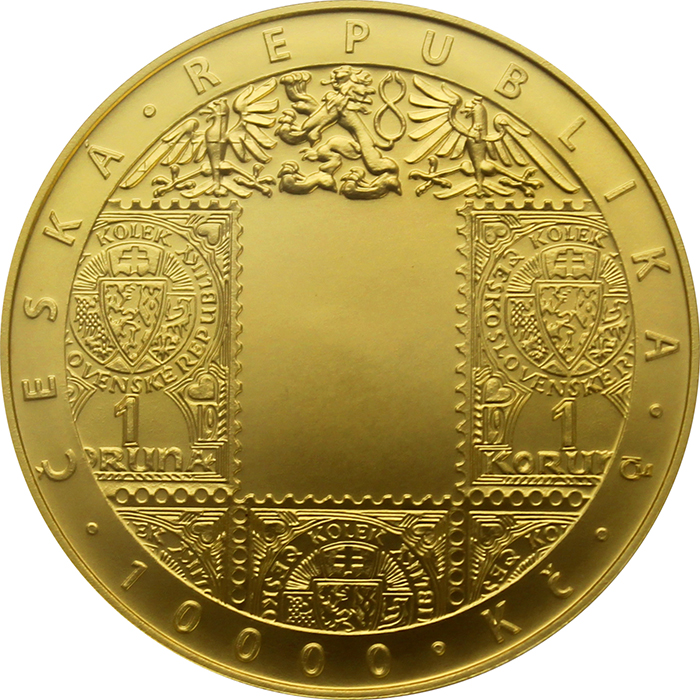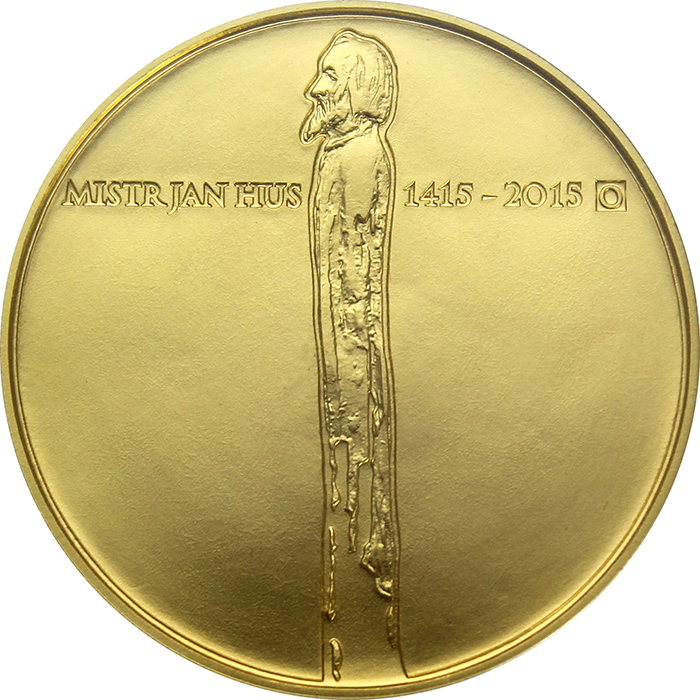Gold Coin 10000 CZK Introduction of the Czechoslovak currency 1oz 2019 Standard
The product cannot be ordered now.
NOT IN STOCK
View the product
Detailed description
Extraordinary mintage of gold coins - 10000 CZK Introduction of Czechoslovak currency
The reverse side of the coin is dominated by a 1 K collector, which is torn from the sheet depicted on the obverse side and symbolically placed on the Hungarian side of the Austro-Hungarian Bank 100 K banknote, model 1912. The text "CZECHOSLOVAK CURRENCY" and the years "1919 - 2019" placed in the intercircle are inscribed around the perimeter of the coin. The initials of the author of the coin MgA. Josef Oplištil, which are formed by the composition of the letters "J" and "O".
The obverse side of the coin features a perforated sheet of 1 K stamps with the middle stamp torn out. The heraldic animals from the great state emblem are placed in the upper part of the coin field. The name of the state 'CZECH REPUBLIC', the denomination of the nominal value of the coin with the abbreviation of the monetary unit '10 000 CZK' and the mark of the Czech Mint, which is formed by a composition of the letters 'Č' and 'M', appear around the perimeter of the coin in the intercircle.
Each coin is accompanied by a red catalogue card with a description of the coin and its plastic representation.
First Czechoslovak currency
The Czechoslovak koruna was established by Act No. 84 of 25 February 1919, on the basis of which the Austro-Hungarian banknotes were withdrawn and minted between 3 and 19 March 1919 and gradually replaced by new Czechoslovak stamp notes until July 1920. The first currency of the new state was the 100 koruna state note of 15 April 1919. The first coins were the 20 and 50 penny with the year of mintage 1921 issued in February 1922. The first koruna coin was also released into circulation in 1922. The first real banknote (not a state note) was the 20 koruna with the date 1 October 1926, but it did not enter circulation until March 1927.

On 14 April 1920, the law on the Cedula Bank was passed, which preceded the creation of the Central Bank, which was not finally established until 21 March 1926 and did not start its activities until 1 April 1926. The first governor was Vilém Pospíšil, who was by then the chief director of the Municipal Savings Bank of Prague and was also a friend of Alois Rašín and a leading financial expert in the country.
After the Second World War, a currency reform was implemented on 1 November 1945, which solved the problem that too many currencies were circulating in Czechoslovakia - in addition to the five currencies (Protectorate, Reichsmark, Slovak, Hungarian and Polish), there were also various military vouchers. Moreover, this reform was coupled with the nationalisation of banks and enterprises under the Benes decrees. The situation was partially stabilised, but the country remained in economic chaos due to the nationalisation and the new status of key companies in industry. After February 1948, further nationalisation of industry took place.
The next currency reform came on 1 June 1953. The new Czechoslovak koruna was exchanged at a ratio of 1:5 for amounts up to CZK 300 (old); higher amounts were exchanged at a ratio of 1:50. In addition, Czechoslovakia ceased to be a member of the IMF and the World Bank, which it had co-founded in 1944, at the end of 1954. After the currency reform in 1953, most people were impoverished and prices began to rise. By the end of the 1950s, the situation had stabilised, but it became clear that centrally managed policies were beginning to show significant economic weaknesses. The 1960s saw the liberalisation of conditions in Czechoslovakia, but this was halted by the Soviet invasion in August 1968. Then came normalisation, when the whole economy was detached from real developments in the world and the gradual isolation of the Czechoslovak economy took place. Inflation was on the rise, which the government hid with currency subsidies and the isolation of the koruna against other currencies. The economic problems of the centrally controlled economy were one of the reasons for the collapse of the communist regime in the Czechoslovakia in November 1989 and the Velvet Revolution.
On January 1, 1993, the Czech and Slovak Federative Republics were divided into two separate states, and on February 8, 1993, the Czechoslovak koruna ceased to exist. The exchange ratio to the successor currencies was 1:1. These became the Czech koruna and the Slovak koruna, which was replaced in Slovakia by the euro on 1 January 2009.
Product Specifications
Application form
Thanks to our position on the market, we can try to provide you with a product that is currently sold out or unavailable for a longer period of time. Simply fill in the application form and we will contact you as soon as we are able to secure the product.
Filling in the application form is not binding for you.
Buyback contact form
We will be happy to buy investment metals purchased from us or from our competitors. Our customers always get the highest price offered at any given time. Fill out the form below and we will contact you. Thank you for your trust.
























